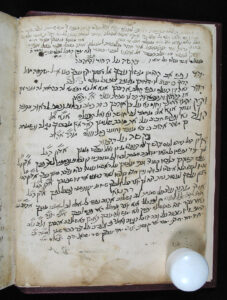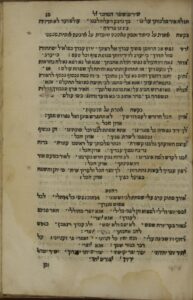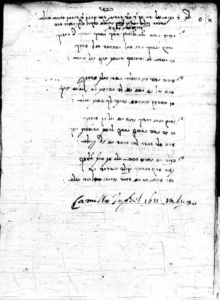| Source (Hebrew) | Translation (English) |
|---|---|
|
יְדִיד נֶֽפֶשׁ אָב הָרַחֲמָן,
מְשׁוֹךְ עַבְדְּךָ אֶל־רְצוֹנֶֽךָ, יָרוּץ עַבְדְּךָ כְּמוֹ אַיָּל, יִשְׁתַּחֲוֶה אֶל מוּל הֲדָרֶֽךָ, יֶעֱרַב לוֹ יְדִידוֹתֶֽיךָ, מִנּוֹפֶת צוּף וְכׇל־טָֽעַם׃ |
Loved of my soul! Father of grace!
Lead on Thy servant to Thy favouring sight; He, fleetly as the hart, shall speed his pace To bow him low before thy glorious might. Sweet is Thy love to him beyond compare, Sweeter than honey, fairer than things fair. |
|
הָדוּר נָאֶה זִיו הָעוֹלָם,
נַפְשִׁי חוֹלַת אַהֲבָתֶֽךָ, אָנָּא אֵל נָא רְפָא נָא לָהּ, בְּהַרְאוֹת לָהּ נוֹֽעַם זִיוֶֽךָ, אָז תִּתְחַזֵּק וְתִתְרַפֵּא, וְהָיְתָה לָּהּ שִׂמְחַת עוֹלָם׃ |
Splendour of worlds! honoured, adored!
My soul is sick with pining love of Thee; My God! I pray Thee, heal her: be implored; And o’er her let Thy holy sweetness be A soothing strength to stay her yearning sore; And joy shall be for her for evermore. |
|
וָתִיק יֶהֱמוּ נָא רַחֲמֶֽיךָ,
וְחוּסָה נָא עַל בֵּן אֲהוּבֶֽךָ, כִּי־זֶה כַּמָּה נִכְסוֹף נִכְסַפְתִּי, לִרְאוֹת בְּתִפְאֶֽרֶת עֻזֶּֽךָ, אָנָּא אֵלִי חֶמְדָּת לִבִּי, חוּסָה נָא וְאַל תִּתְעַלָּם׃ |
Source of all good! pity Thou me!
And be Thou moved for thy beloved son, For lo, how oft my soul hath longed to see The beauty of Thy strength, Thou Mighty One! Ah, Thou my God, my heart’s desire, I pray Grant me Thy mercy; turn Thee not away. |
|
הִגָּלֶה נָא וּפְרוֹס חָבִיבִי
עָלַי אֶת סֻכַּת שְׁלוֹמָךְ תָּאִיר אֶֽרֶץ מִכְּבוֹדֶֽךָ, נָגִֽילָה וְנִשְׂמְחָה בָּךְ, מַהֵר אָהוּב כִּי בָא מוֹעֵד, וְחָנֵּֽנוּ כִּימֵי עוֹלָם׃ |
Be Thou revealed, Dearest of mine!
And spread o’er me Thy canopy of peace; Soon with Thy glory all the earth shall shine; And we shall know a joy that shall not cease. Hasten, Beloved, for the time is nigh, And have compassion as in days gone by. |
“Yedid Nefesh” is a piyyut first published in the Sefer Haḥaredim (1588) of Rabbi Elazar Moshe Azikri (1533-1600). The authorship of the piyyut is not completely certain. A version of the piyyut “with noteworthy text, spelling and pointing” may be found on folio 146 (verso) of Samuel b. David b. Solomon’s Commentary On the Book of Numbers (ca. 1437 CE).[1] Find Stefan C. Reif’s The Hebrew Manuscripts at Cambridge University Libraries: A Description and Introduction Cambridge: Cambridge University Press, 1997, page 93. Reif attributes Yedid Nefesh to Azkiri. Presumably, the text must have been added to the 15th century manuscript sometime after the publication of Sefer Haḥaredim. It would be very nice to see a digitized image of this manuscript page from the CUL collection! Yedid Nefesh also appears in Moscow – Russian State Library, Ms. Guenzburg 320 as the last of “a polyglot of at least 24 different items written in different stages” (find Dr. Ezra Chwat, גילוי מילתא בעלמא Giluy Milta B’alma). Yedid Nefesh appears there under the following headline: ד’ בתים של שם בן ד’ ב”ה ששמענו מפי קדוש מכבוד החכם השלם מהר”ר גדליה בן לגאון המושלם המקובל [הא]לקי כמהר”ר משה קורדוברו זצק”ל”. Ezra Chwat: “This doesn’t necessarily qualify that Gedalia Cordovero (1562–1625, son of Moshe Cordovero, ReMaK), is the author. To be precise, it attributes to him the oral transmission.” Meir Benayahu in Yosef Behiri, 1991, p.544, “asserts that this witness must have heard the poem from Gedalia Cordevero after his descent [from Safed] to Italy in 1583. This would be a full five years before Ḥaredim was written (and 17 years before [it was] published). Having been transmitted orally for some time might explain some of the variants. In any case Gedalia Cordevero and Elazar Azkari are likely to have been well acquainted.” The piyyut has appeared with a number of variations in various siddurim.
At the time that Nina Salaman made her translation in the Jewish Quarterly Review (1897, o.s. IX, p.290), the attribution of Yedid Nefesh was far less certain. –Aharon Varady
Source(s)



Yedid Nefesh (JTSA MS3541, fol.5v) yedid nefesh – sefer haḥaredim 43a (Venice 1597)

Notes
| 1 | Find Stefan C. Reif’s The Hebrew Manuscripts at Cambridge University Libraries: A Description and Introduction Cambridge: Cambridge University Press, 1997, page 93. Reif attributes Yedid Nefesh to Azkiri. Presumably, the text must have been added to the 15th century manuscript sometime after the publication of Sefer Haḥaredim. It would be very nice to see a digitized image of this manuscript page from the CUL collection! |
|---|




